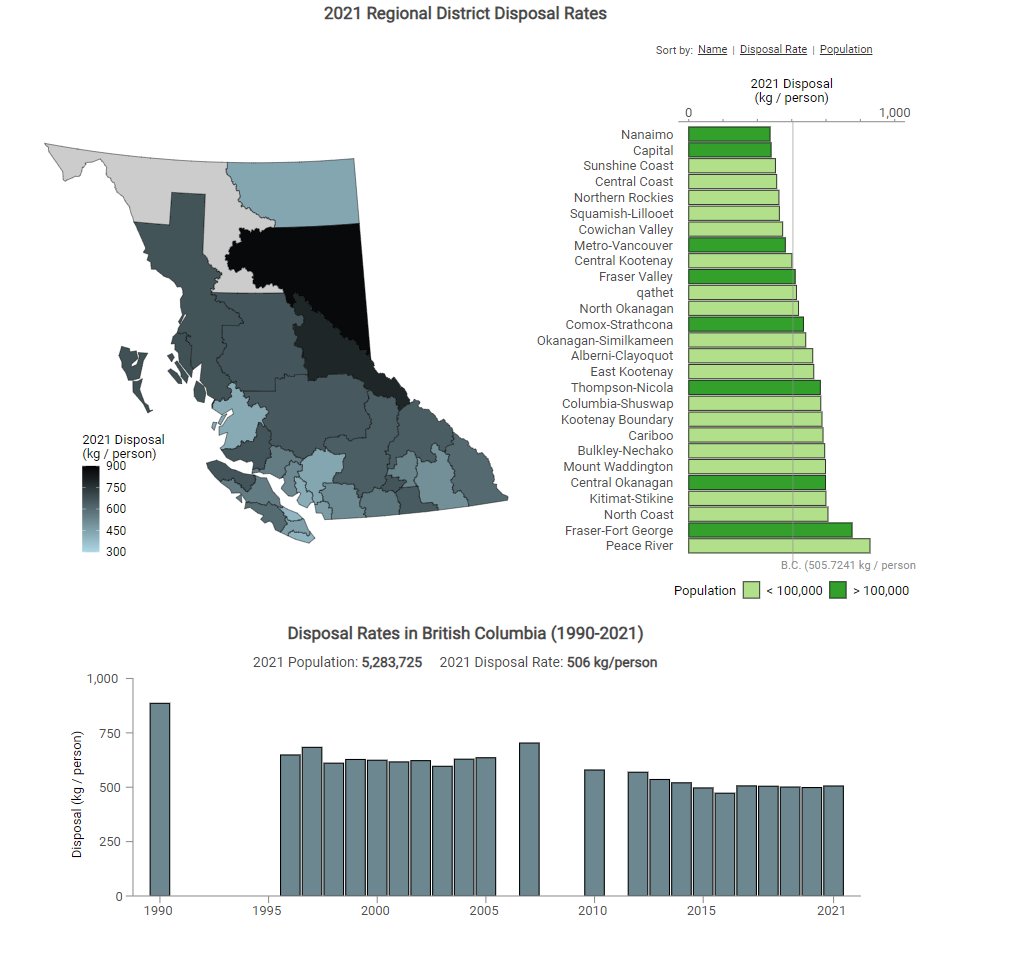Municipal Solid Waste Disposal in B.C. (1990-2023)
This indicator reports the estimated amount of municipal solid waste disposed per person for each regional district and for British Columbia. The per person disposal rate is an estimate of how many kilograms of solid waste each B.C. resident sends to a landfill or other disposal site in a given year.
Tip: Click on the regional districts in the chart on the right or the map on the left to show disposal rate history from 1990-2023 for that region. If available, links to Regional District Solid Waste Management Plans and Waste Compositions Reports are provided below the chart.
Key Facts and Figures
- Approximately 2.7 million tonnes of municipal solid waste was disposed of in B.C. in 2023. While there has been an overall decreasing trend in municipal solid waste disposal rates since the 1990s, much of the waste disposed of could be reduced (by not being generated in the first place), repurposed, composted or recycled.
- Waste reduction efforts are more and more important as B.C. population continues to increase, landfills approach their capacity for receiving new waste, and the imperative to reduce greenhouse gas emissions from waste disposal grows.
- Tracking waste disposal across B.C. is important as it provides historical trend information and the current status of waste disposal—both of which inform and guide efforts to reduce the amount of waste we create.
- In 2023, British Columbians disposed of an average of 481 kg of municipal solid waste per person — down 88 kg per person since 2012, though higher than the low of 473 kg/person in 2016.
- Provincial initiatives which support decreases in waste disposal rates include the CleanBC Plastics Action Plan, organics diversion, food waste prevention, extended producer responsibility (recycling) programs, and funding for organics infrastructure and collection.
- Variability in disposal rates from one region to the next is influenced by factors such as population density, economic activity, tourist and transient population fluctuations, distance to recycling markets, the role of various stewardship agencies operating in an area and the capacity and infrastructure in place in a region. While disposal rate data do not tell the whole story, they are useful in setting the stage for continuous improvement in waste management in B.C.
What is Included in the Disposal Rate?
Disposal rates reported here include waste from the residential sector, institutional, commercial, and light industrial sources as well as waste from construction, renovation, and demolition activities.
Disposal rates do not include hazardous, biomedical, or agricultural waste, motor vehicles or components, heavy industry, or contaminated soil.
Waste that is reused or recycled is also not included.
Interpreting the Data:
- 2023 disposal rates were provided by regional districts.
- Where no bar is shown on a chart for certain previous years, a verifiable estimate was not available.
- Historic disposal rates cannot be directly compared between years because the data were collected using different methods. However, the data from 2012 onward have been collected using the same methodology.
- Regional district population estimates are sourced from BC Stats. Alberni-Clayoquot, Metro Vancouver, Squamish-Lillooet, and East Kootenay Regional Districts and Northern Rockies Regional Municipality population estimates have been adjusted to take into account tourist populations, based on data submitted by the regional districts.
- Disposal rates for Comox Valley and Strathcona are reported as one as they manage their waste streams together.
Regional districts that wish to update the waste disposal data reported above should contact the Environmental Policy and Initiatives Branch. Input from regional districts will also serve to inform future waste reporting methodology development.
The R code supporting this indicator is available on GitHub.
References and Other Useful Links
- Find out where to recycle using the Recycling Council of British Columbia’s Recyclepedia App
- B.C.'s recycling system (EPR) and regulations
- Solid Waste Management Planning in B.C.
- British Columbia's Environmental Management Act
- British Columbia Ministry of Environment and Climate Change Strategy 2025/26 – 2027/28 Service Plan (March 2025) (PDF)
Data
*By accessing these datasets, you agree to the licence associated with each file, as indicated in parentheses below.
Download a printable version of this indicator (PDF)
Updated December 2025
Suggested Citation: Environmental Reporting BC. 2025. Municipal Solid Waste Disposal in B.C. (1990-2023). State of Environment Reporting, Ministry of Environment and Parks, British Columbia, Canada.


 Your
screen is too small to display the interactive charts. Click to see the interactive visualization in
full-screen.
Your
screen is too small to display the interactive charts. Click to see the interactive visualization in
full-screen.